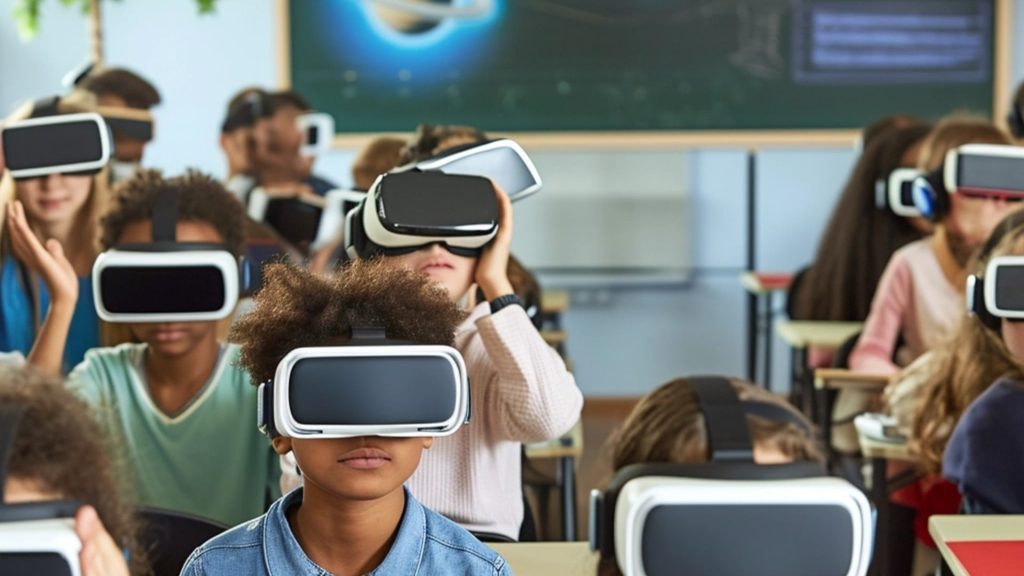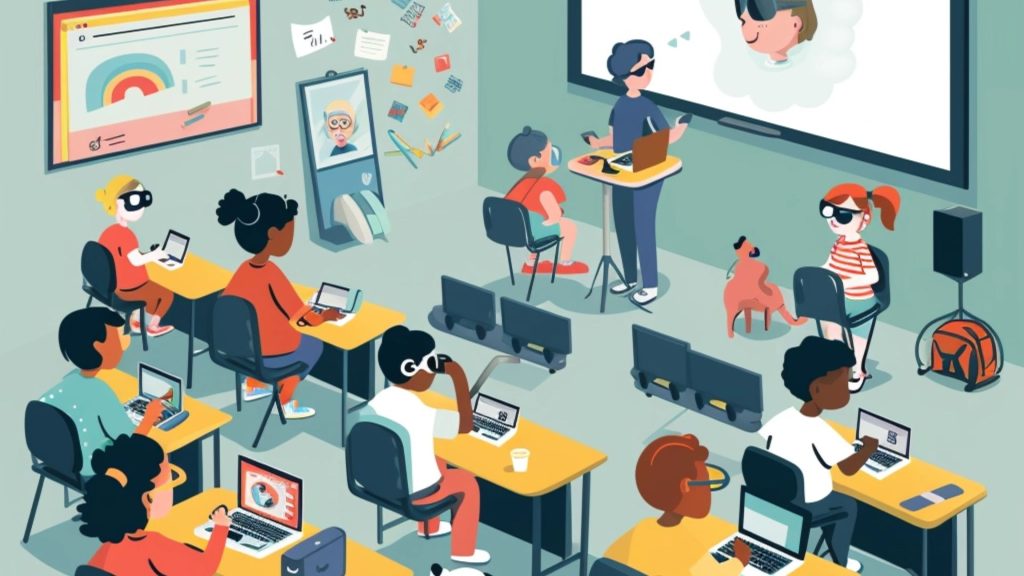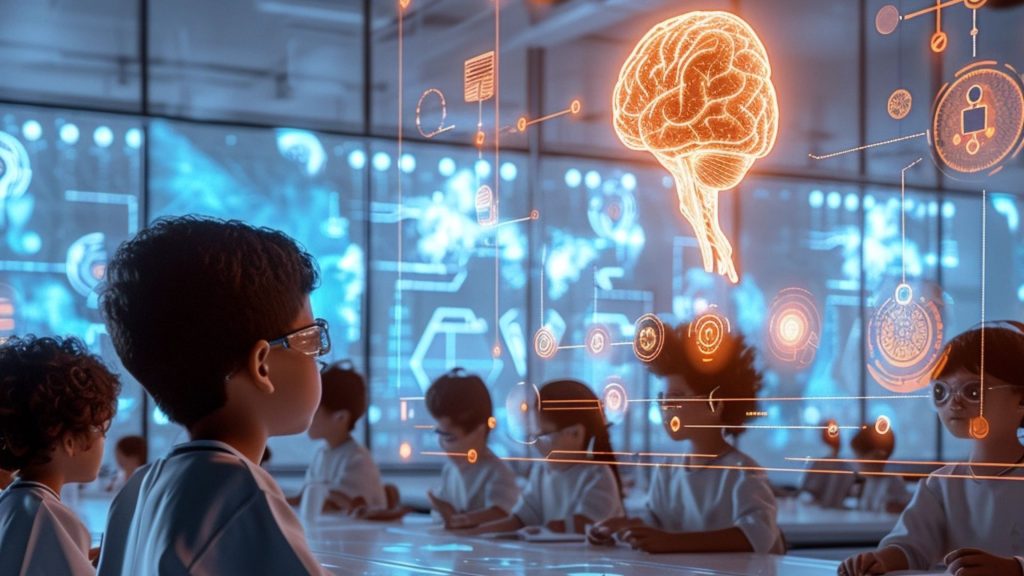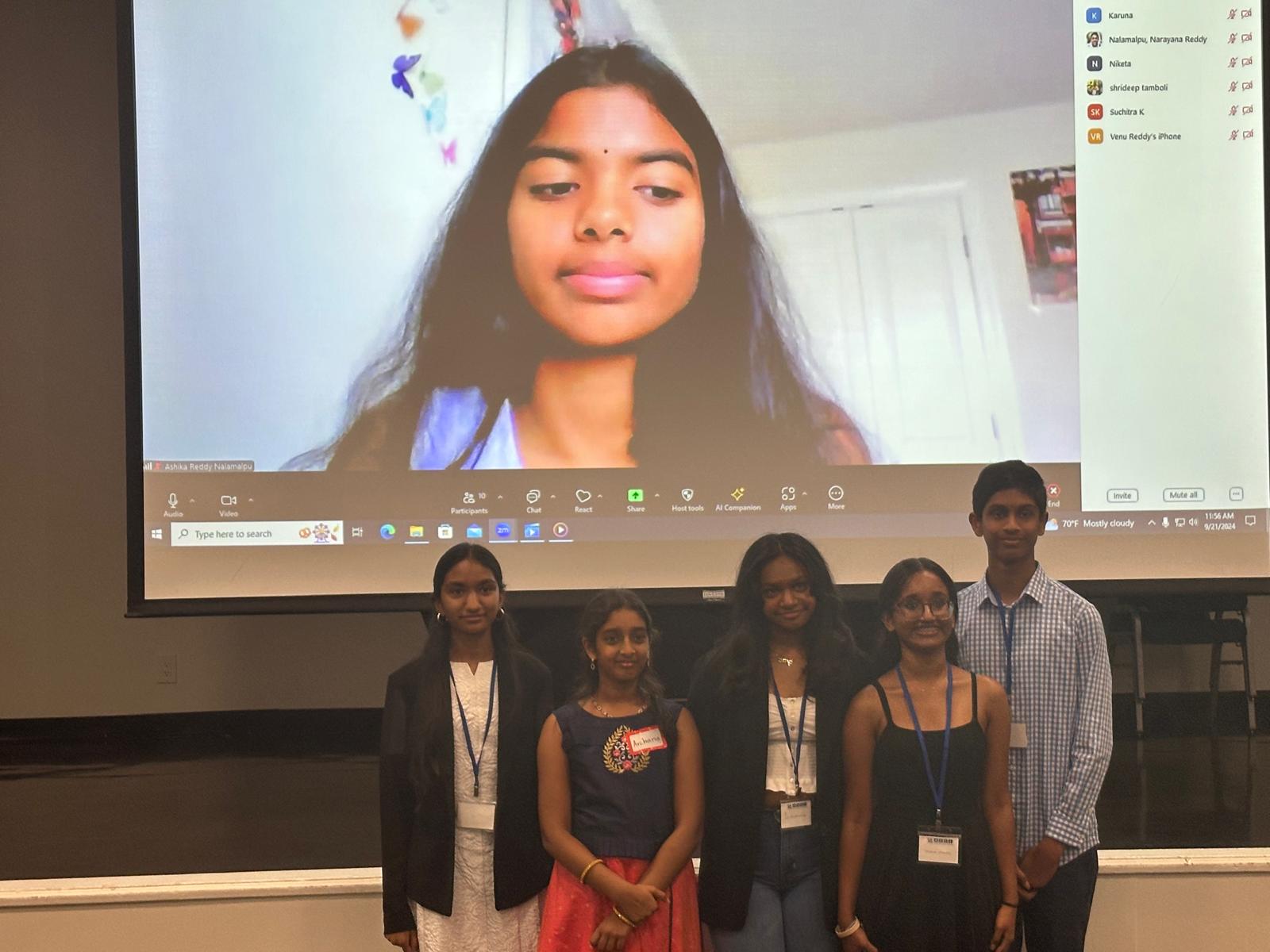Generative AI focuses on creating new data or content rather than simply analyzing existing information or making predictions based on patterns. Unlike traditional AI, which primarily relies on predefined rules and structured data, Generative AI systems have the ability to generate novel outputs, such as images, text, or audio, that mimic human creativity and intelligence.
The importance of AI in education cannot be overstated. As the world becomes increasingly driven by technology, it is essential for educational institutions to equip students with the skills and knowledge they need to thrive in the digital age. AI has the power to enhance teaching effectiveness, improve learning outcomes, and prepare students for the jobs of the future. By embracing AI in education, we can empower children to become lifelong learners who are adaptable, critical thinkers, and well-prepared to thrive in an ever-evolving digital world.
Benefits of Integrating Generative AI in Education Through Schools
The integration of Generative AI holds immense promise for transforming education by offering a myriad of potential benefits:
a. Personalized Learning Experiences
Generative AI enables the creation of personalized learning materials tailored to individual student needs and preferences. By analyzing student data and learning patterns, AI algorithms can generate adaptive content, exercises, and tutorials, facilitating personalized learning journeys that cater to diverse learning styles and abilities.
b. Enhanced Creativity and Innovation
Generative AI tools empower students and educators to unleash their creativity and explore new frontiers of innovation. From generating artwork and music compositions to crafting storytelling narratives, AI-driven creativity tools inspire experimentation and collaboration, fostering a culture of innovation and expression in educational settings.
c. Automated Assessment and Feedback
AI-powered assessment tools streamline the process of evaluating student performance and providing timely feedback. Through machine learning algorithms, educators can automate grading tasks, analyze student responses, and offer personalized feedback, freeing up valuable time for more meaningful interactions and instructional activities.
d. Real-world Application and Problem Solving

Generative AI equips students with practical skills and problem-solving abilities relevant to real-world challenges. By engaging with AI-driven simulations, virtual laboratories, and scenario-based learning experiences, students gain hands-on experience in applying theoretical concepts to real-world scenarios, preparing them for future careers and societal challenges.
Potential GenAI Applications at Schools
Here are some compelling examples of potential GenAI applications that can be used at schools.
a. AI-based Tutoring Systems
AI-based tutoring systems utilize sophisticated algorithms to analyze individual learning patterns and provide tailored feedback and guidance. Many platforms leverage AI to offer interactive lessons and adaptive exercises in subjects ranging from mathematics to language learning. By adapting content and pacing to match each student’s proficiency level, AI tutoring systems support self-paced learning and help students achieve mastery in diverse subject areas. Moreover, they offer immediate feedback and targeted interventions, empowering students to address their learning gaps and maximize their academic potential.
b. Smart Classrooms and Learning Management Systems
Smart classrooms integrate technology such as interactive whiteboards, tablets, and smart projectors to create interactive and engaging learning environments. LMS platforms utilize AI algorithms to streamline administrative tasks, deliver personalized learning content, and track student progress. These systems facilitate seamless communication between teachers and students, enable collaborative learning activities, and provide access to a wealth of educational resources.
c. Virtual Reality (VR) and Augmented Reality (AR) Applications
In education, VR and AR offer innovative ways to engage students and enhance understanding of complex concepts. For example, students can virtually explore historical sites, dissect virtual organisms, or conduct science experiments in simulated environments. AR applications can overlay digital annotations onto physical objects, making learning materials more interactive and engaging. Additionally, VR and AR enable remote collaboration and virtual field trips, breaking down geographical barriers and providing access to educational experiences that may not be possible in traditional classrooms.
d. Assistive Technologies for Special Education

Assistive technologies aim to enhance accessibility, facilitate communication, and promote independence in educational settings. One example of assistive technology is text-to-speech software, which converts written text into spoken language, enabling students with visual impairments or reading difficulties to access written materials more easily. Similarly, speech recognition software allows students with motor disabilities to input text using voice commands, enhancing their ability to participate in writing activities. Other examples of assistive technologies include communication devices such as augmentative and alternative communication (AAC) systems, which help nonverbal students communicate effectively using symbols, pictures, or speech-generating devices. For students with learning disabilities, assistive technologies like graphic organizers and mind-mapping software can support organization, comprehension, and information processing. Moreover, specialized hardware such as adaptive keyboards, switches, and joysticks enable students with physical disabilities to navigate digital interfaces and interact with computers more effectively.
Challenges in Implementing Generative AI in Schools
a. Despite the potential benefits, implementing Generative AI in educational settings comes with its own set of challenges. One significant hurdle is the lack of resources and infrastructure necessary to support AI integration. Many schools may not have access to the computational power or expertise required to deploy and maintain AI systems effectively.
b. Resistance to technological change is another obstacle that schools may encounter. Educators and administrators may be hesitant to adopt new technologies due to concerns about their effectiveness, relevance to the curriculum, or impact on traditional teaching methods. Overcoming this resistance requires proactive efforts to demonstrate the value of Generative AI and provide support and training to educators.

c. Security and privacy concerns also loom large in the implementation of Generative AI in schools. Given the sensitive nature of student data, educators must ensure that AI systems are deployed in compliance with relevant regulations and guidelines. There is a need for robust data protection measures and transparent policies to address potential risks such as data breaches or algorithmic biases.
Ethical Considerations and Concerns
In the realm of integrating Generative AI into educational settings, ethical considerations play a pivotal role in shaping its implementation. Four primary ethical concerns arise:
a. Bias and Fairness Issues
In educational contexts, biased algorithms can perpetuate existing inequalities by favoring certain demographic groups or reinforcing stereotypes. It’s crucial to ensure that AI-driven educational tools are designed and trained on diverse datasets to mitigate bias and promote fairness.
b. Accountability and Transparency
Educators and stakeholders may struggle to understand how AI systems arrive at decisions, leading to questions about accountability in the event of errors or biases. To address this, developers must prioritise transparency by providing clear explanations of AI-generated outcomes and fostering accountability mechanisms for responsible AI use in education.
c. Intellectual Property Rights
Educational institutions must navigate complex legal and ethical landscapes to determine ownership rights over AI-generated content. Clear policies and agreements are necessary to protect the intellectual property of both creators and institutions while encouraging innovation and collaboration.
d. Potential for Misuse and Manipulation
Malicious actors could exploit AI-generated content to spread misinformation, cheat on assessments, or engage in unethical behaviors. Safeguards such as authentication mechanisms and content validation processes are essential to prevent misuse and maintain the integrity of educational environments.
Strategies for Overcoming Barriers to Adoption
While the integration of generative AI in educational settings holds great promise, it also presents various challenges that need to be addressed for successful implementation. Here are some strategies for overcoming barriers to adoption:
a. Investment in Training and Professional Development
To effectively leverage generative AI tools, educators require training and professional development programs to enhance their digital literacy skills and familiarity with AI technologies. Schools and educational institutions should invest in workshops, courses, and resources to empower educators with the knowledge and expertise needed to integrate AI into their teaching practices.
b. Collaboration with Industry Partners
Collaborating with industry partners and AI experts can provide valuable insights and support in implementing AI solutions in educational settings. Partnering with technology companies, research institutions, and AI developers enables schools to access cutting-edge AI technologies, receive guidance on best practices, and co-create tailored solutions that meet specific educational needs.
c. Development of Clear Policies and Guidelines
Establishing clear policies and guidelines regarding the ethical use of AI in education is essential to address concerns related to privacy, data security, and algorithmic bias. Educational institutions should develop comprehensive policies that outline guidelines for the responsible collection, storage, and use of student data, as well as protocols for addressing issues of bias and fairness in AI-driven systems.
d. Pilot Programs and Case Studies
Implementing pilot programs and conducting case studies can help schools evaluate the efficacy of AI technologies in real-world educational contexts and identify best practices for adoption. By testing AI solutions on a smaller scale and gathering feedback from stakeholders, schools can iteratively refine their approaches, address challenges, and scale successful implementations more effectively.
The Role of Teachers in Teaching and Monitoring Generative AI
As generative AI technologies become increasingly integrated into educational settings, teachers play a crucial role in guiding students’ interactions with these tools and ensuring their ethical and responsible use.
a. Facilitating Ethical Discussions
Teachers have a responsibility to facilitate discussions with students about the ethical implications of using generative AI technologies. This includes addressing issues such as algorithmic bias, privacy concerns, and the potential impact of AI on society. By engaging students in critical conversations, teachers can help them develop a deeper understanding of the ethical considerations surrounding AI.
b. Guiding Student Exploration and Experimentation
Teachers play a vital role in guiding students’ exploration and experimentation with generative AI tools. They can provide guidance on how to effectively use AI technologies for learning purposes, encourage creative experimentation, and scaffold students’ understanding of AI concepts and applications.
c. Monitoring AI-generated Content for Accuracy and Authenticity
Teachers are responsible for monitoring AI-generated content to ensure its accuracy, authenticity, and relevance to educational objectives. This involves critically evaluating AI-generated materials, verifying sources, and addressing any inaccuracies or biases that may arise. By maintaining oversight of AI-generated content, teachers can uphold academic standards and promote critical thinking skills among students.
d. Supporting Student Creativity and Critical Thinking
Teachers play a key role in fostering students’ creativity and critical thinking skills within the context of generative AI. They can encourage students to explore AI technologies as tools for creative expression, problem-solving, and innovation. Additionally, teachers can provide guidance on how to critically evaluate AI-generated content, analyze its strengths and limitations, and make informed judgments.
Future Trends and Opportunities in Generative AI Education
The future of generative AI in education is marked by exciting trends and opportunities that have the potential to reshape teaching and learning practices.

a. Integration of AI into Curriculum Design
As AI technologies become more sophisticated, there is increasing potential to integrate AI into curriculum design across various subject areas. AI-driven adaptive learning platforms can personalize instruction to meet individual student needs, while AI-generated content creation tools can facilitate the development of interactive and engaging learning materials.
b. Advancements in Natural Language Understanding
Breakthroughs in natural language understanding are enabling more seamless interactions between students and AI-powered virtual assistants. Future developments in conversational AI technologies will enhance the effectiveness of virtual tutors and language learning applications, providing students with personalized support and feedback in real-time.
c. Expansion of AI-driven Educational Platforms
The proliferation of AI-driven educational platforms is democratizing access to quality education worldwide. Online learning platforms powered by AI algorithms offer flexible and scalable solutions for delivering personalized instruction, expanding access to educational resources, and bridging the digital divide.
d. Collaboration Between Education and AI Research Communities
Collaboration between the education sector and AI research communities is essential to drive innovation and advance the field of AI in education. By fostering interdisciplinary partnerships, researchers, educators, and technologists can co-create solutions that address the unique challenges and opportunities in educational settings, leading to more effective AI-driven teaching and learning experiences.
Final Thoughts: The Path Forward for Schools to Embrace Generative AI
While the potential benefits of generative AI in education are vast, it is essential to approach its implementation with caution and mindfulness of ethical considerations. Schools must strike a balance between leveraging AI technologies to enhance learning outcomes and mitigating potential risks related to privacy, bias, and security.
Despite the challenges and complexities, there is optimism for the transformative impact of generative AI on education. By embracing innovation, fostering collaboration, and prioritizing the needs of students, schools can harness the full potential of AI to create more equitable, engaging, and effective learning environments for all learners.
{igebra.ai}’s GenAI Master Program is a groundbreaking educational initiative designed specifically for students in grades 5 through 10. Developed by leading AI experts from the United States, this innovative course aims to prepare children for the rapidly evolving GenAI world. Unlike traditional tech education, the program emphasizes a holistic approach, equipping students with not only technical skills but also fostering AI-ready mindsets. The curriculum covers a range of topics, from foundational AI principles to advanced Generative AI techniques. Through hands-on projects and real-world applications, students learn to harness the power of AI to solve meaningful problems and create impactful products. For more information contact on +91 81210 40955.



